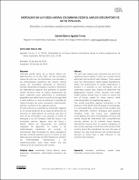| dc.contributor.author | Agudelo-Torres, Gabriel Alberto | |
| dc.date.accessioned | 2019-07-18T14:45:12Z | |
| dc.date.accessioned | 2019-08-01T21:40:06Z | |
| dc.date.available | 2019-07-18T14:45:12Z | |
| dc.date.available | 2019-08-01T21:40:06Z | |
| dc.date.issued | 2015-01-22 | |
| dc.identifier | https://revistas.itm.edu.co/index.php/revista-cea/article/view/32 | |
| dc.identifier | 10.22430/24223182.32 | |
| dc.identifier.uri | http://hdl.handle.net/20.500.12622/538 | |
| dc.description.abstract | Colombia perdió parte de su fuerza laboral por fallecimientos en el año 2011; las dos principales causas de esto son: los homicidios y sus secuelas, y las enfermedades isquémicas del corazón. Dichas causas de mortalidad presentan el fenómeno llamado dependencia espacial. Cuando el fenómeno de dependencia espacial está presente es posible utilizar técnicas como el análisis exploratorio de datos espaciales para determinar la localización geográfica que deben tener las políticas de seguridad y salud pública, en aras de disminuir la pérdida de capital humano por estos conceptos, maximizando, además, su efecto en las regiones vecinas.
En este artículo se cuantifica la interacción regional en el comportamiento de las tasas de defunción de personas en edad laboral. Se concluye que para el caso de los homicidios y sus secuelas, el norte de Antioquia y sur de Córdoba, Valle del Cauca y sus municipios vecinos, algunos otros del Cauca y Nariño, deben ser intervenidos con políticas integrales de seguridad. En cuanto a las enfermedades isquémicas del corazón, la intervención debe focalizarse en varias subregiones del país, teniendo presente que en el centro no solo debe atacarse este tipo de enfermedad sino también las enfermedades hipertensivas y las cerebrovasculares, pues estas tienen una alta influencia en las isquémicas del corazón. | spa |
| dc.format.mimetype | application/pdf | |
| dc.language.iso | spa | |
| dc.publisher | Instituto Tecnológico Metropolitano - ITM | spa |
| dc.relation | https://revistas.itm.edu.co/index.php/revista-cea/article/view/32/285 | |
| dc.relation | https://revistas.itm.edu.co/index.php/revista-cea/article/view/32/286 | |
| dc.rights | Derechos de autor 2017 Revista CEA | spa |
| dc.source | 2422-3182 | |
| dc.source | 2390-0725 | |
| dc.source | Revista CEA; Vol 1 No 1 (2015); 23-49 | eng |
| dc.source | Revista CEA; Vol. 1 Núm. 1 (2015); 23-49 | spa |
| dc.subject | mortalidad | spa |
| dc.subject | fuerza laboral | spa |
| dc.subject | datos espaciales | spa |
| dc.subject | homicidios | spa |
| dc.subject | enfermedad isquémica del corazón. | spa |
| dc.title | Mortalidad en la fuerza laboral colombiana desde el análisis exploratorio de datos espaciales | spa |
| dc.title.alternative | Mortality in colombian workforce from exploratory analysis of spatial data | eng |
| dc.type.spa | Artículos | spa |
| dc.subject.keywords | mortality | eng |
| dc.subject.keywords | workforce | eng |
| dc.subject.keywords | spatial data | eng |
| dc.subject.keywords | homicide | eng |
| dc.subject.keywords | ischemic heart disease. | eng |
| dc.type | info:eu-repo/semantics/article | |
| dc.type | info:eu-repo/semantics/publishedVersion | |
| dc.type | Articles | eng |
| dc.relation.ispartofjournal | Revista CEA | |
| dc.description.abstractenglish | The two main reasons why Colombia lost part of its workforce due to deaths in 2011 are: murder and its aftermath and ischemic heart disease. These causes have the phenomenon called spatial dependence. When the phenomenon of spatial dependence is present it is possible to use techniques such as exploratory spatial data analysis to determine the geographical location which security and public health policies should have in order to reduce the loss of human capital for these reasons, while maximizing effect on neighboring regions. This article quantifies regional interaction in the behavior of the death rates of people of working age. It is concluded that, in the case of the murders and their aftermath, northern Antioquia and southern Córdoba, Valle del Cauca and neighboring municipalities and some municipalities of Cauca and Nariño should be intervened with comprehensive security policies. As for ischemic heart disease, intervention should focus on several subregions of the country, bearing in mind that in the center of the country should be considered not only this type of disease, but also hypertensive and cerebrovascular diseases as these have a high influence in the ischemic heart disease. | eng |
| dc.rights.accessrights | info:eu-repo/semantics/openAccess | |
| dc.type.coar | http://purl.org/coar/resource_type/c_6501 | |


